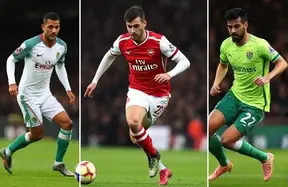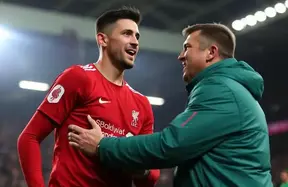A prominent tactical breakdown spotlighted a shared trend across the latest matches: heavy left-sided bias. Liverpool repeatedly funneled play left, with Curtis Jones naturally gravitating there and Conor Bradley offering less natural width than an orthodox right wing-back. Bayer Leverkusen felt Jeremie Frimpong’s absence in stretching the right touchline, while Florian Wirtz drifted into the left half-space to find touches. Alexander Isak and Hugo Ekitike, in their respective teams, also favored the left channels when interchanging. The debate spilled across fan bases, with some praising improved first-phase structure and others pointing to Arsenal’s full-backs as a contrasting, goal-hungry model.

The discussion emerged around a busy matchday in England and Germany. Observers highlighted Liverpool’s left-leaning buildup with Curtis Jones’ positioning, while noting Leverkusen’s struggle to maintain right-sided width without Jeremie Frimpong. Florian Wirtz’s preference for the left half-space, and forward tendencies from Alexander Isak and Hugo Ekitike to drift left, fed a wider conversation on balance and spacing. Meanwhile, chatter about Arsenal’s full-backs and their end-product offered a contrasting benchmark for full-back contribution in the final third.
Liverpool have a strong left-sided bias. Frimpong’s injury was a blow as he holds the width better than Bradley. Wirtz is drifting too much towards the left. Isak and Ekitike also have license to interchange but they both prefer the left. Jones also prefers that side. 🤦♂️
@EBL2017
Impact Analysis
The left-sided bias has two immediate tactical consequences. First, predictability: opponents can cue their pressing traps and overloads to one flank, compressing space and forcing low-value crosses or turnovers. For Liverpool, repeated left-leaning patterns reduce the surprise element, even if the left is stocked with technically secure profiles like Curtis Jones. Second, destabilized rest-defense: when circulation skews to one side without mirrored weak-side threats, defensive transitions lengthen as the ball must travel farther to protect space behind the ball.
Leverkusen’s issue without Jeremie Frimpong underscores the irreplaceable value of true width. His high-and-wide occupation pins full-backs and opens interior lanes for Florian Wirtz. When that width disappears, Wirtz’s natural solution—drifting left to find touches—can crowd the zone and blunt central rotations. Similarly, forwards such as Alexander Isak and Hugo Ekitike preferring the left channel can overconcentrate play and narrow the pitch. In contrast, Arsenal’s current full-back productivity (with Riccardo Calafiori and Jurrien Timber stepping into goalscoring roles) illustrates how balanced width and timed underlaps create dual-sided threats that stretch blocks and diversify chance creation.
Reaction
Fan reaction split along experience and club lines. Liverpool supporters debated whether the team’s first phase had genuinely improved. One view credited a steadier base with Dominik Szoboszlai anchoring and Curtis Jones dropping to help, which smoothed circulation and limited the chaotic, everyone-forward sequences seen in prior high-profile games. Others worried that without a true right-side stretcher, the ball gravitated left, telegraphing attacks and reducing Mo Salah’s isolation moments on the far side.
From the Bundesliga angle, many pointed out how much Leverkusen rely on Jeremie Frimpong’s width; without him, Wirtz drifted left to stay involved, but that congested the channel and flattened the team’s staggering. Neutral fans latched onto a broader theme: modern forwards like Isak and Ekitike increasingly prefer the left half-space for curved runs and right-footed finishing lanes, which can make teams look lopsided if not counterbalanced.
Arsenal chatter entered the thread as a counterexample, with supporters citing the scoring impact of Calafiori and Timber and a more symmetrical structure. Some rival fans took playful shots—“sorry for Mo!”—arguing that starting build-ups on the left has more bite, while a few tactical purists insisted the problem isn’t the side itself but the lack of synchronized weak-side activation to punish shifts.
Social reactions
Aaaaand Szoboszlai has left side bias, MacAllister too etc almost all of our squad ffs
Hidajet Beqaj (@HidajetBee97)
All we need is a pacy and technical RW and you'll see them drift to the right.
Sir Israel (@SirIsraellfc)
🚨 Arne Slot: “Alexander Isak had to be subbed off due to discomfort he felt in his groin”. “Let’s hope it’s not too bad. It's such a difficult balance to find with a player that missed three months”.
Fabrizio Romano (@FabrizioRomano)
Prediction
Expect coaching staffs to chase balance in three ways. First, personnel: right-sided width merchants will see minutes rise. For Liverpool, that could mean sequences designed to spring the right flank earlier—staggering the right-back higher in settled possession or rotating a right-footed winger/8 into wider positions to pin the last line. Second, role tweaks: at Leverkusen, a fit-again Frimpong restores the natural stretch, allowing Wirtz to hold the right half-space on the start and arrive left on rotations rather than camping there. That keeps central corridors live while preserving crossing threat on the weak side.
Third, pattern design: expect deliberate “escape” automations to the right—third-man switches, diagonal wall-passes, and inverted-to-overlap sequences that flip the overload late in the attack. For teams with left-drifting forwards like Isak and Ekitike, coaches should rehearse mirror patterns to the right, using back-post runs and cutbacks to equalize expected threat. If Arsenal continue to extract final-third value from full-backs, more sides will trial underlapping full-backs on the far side to arrive undetected.
In the medium term, clubs will shop for either a left-footed right-wing profile or an athletic right-back who can hold width and deliver early. That market signal—pace plus crossing on the right—will grow louder if current left heavy schemes stagnate against organized mid-blocks.
Latest today
- Man United cool Dabo pursuit after sealing Cristian Orozco, backing U18 gem Jim Thwaites
- Arsenal’s structural wobble after Villa defeat fuels renewed push for Piero Hincapié
- Arsenal’s next move after brutal Villa test: Gyokeres and Zubimendi fit the fix
- Xabi Alonso hints Eder Militao could cover at right back for Real Madrid
Conclusion
Left-sided bias isn’t inherently bad; it’s a powerful identity when supported by fast switches, weak-side threats, and rest-defense behind the ball. The problem arises when preference becomes predictability. Liverpool’s left tilt suits Curtis Jones’ rhythm, but the right lane must threaten earlier to keep Salah and the back-post alive. Leverkusen’s blueprint shows how crucial Frimpong’s width is to freeing Florian Wirtz between lines; without it, the attack narrows and loses verticality. For forwards like Isak and Ekitike, the left half-space is home, but teams must engineer matching danger on the opposite side.
Arsenal’s recent full-back outputs underline a simple lesson: varied arrival points make blocks crack. If the current discourse triggers micro-adjustments—healthier staggering, quicker diagonals, restored right-side occupation—expect immediate gains in chance quality and transition security. The next step is turning these tweaks into habit, so left-leaning identities remain a strength, not a scouting report giveaway.













Hidajet Beqaj
Aaaaand Szoboszlai has left side bias, MacAllister too etc almost all of our squad ffs
Sir Israel
All we need is a pacy and technical RW and you'll see them drift to the right.
Fabrizio Romano
🚨 Arne Slot: “Alexander Isak had to be subbed off due to discomfort he felt in his groin”. “Let’s hope it’s not too bad. It's such a difficult balance to find with a player that missed three months”.
OptaJoe
19 - English sides scored 19 goals on this UEFA Champions League matchday - the most ever by a nation's clubs in one matchday. 5 Chelsea 5 Liverpool 4 Arsenal 3 Newcastle United 2 Manchester City 0 Spurs Abundance.
Israil Thomas
If Wirtz just stays on the right it balances. He can float no problem. Just float on the right side of the pitch. Don't come left. There's plenty of playmaking on the left they don't need him
xyz
But Chiesa changed the game , just by pressing and defensive contribution, gave enough room to nearby players for better pass
rAj
Exactly But our attack somehow prefers the right side as an initiative, don't know why! Starting with the left will have more impact, sorry for Mo!
fifo007_LFC
Bro are we playing better Or are frankfurt too defensive? I feel against United we had no one holding his position in the 6, everybody pushed up brainlessly. Today Szobo is playing 6, jones is dropping back to help Szobo which is making our first phase play better. Am i right?
Ryan
Do you think Wirtz is drifting there because that's clearly the area he prefers to be in?
Shikhar
Only for this reason, they shouldn’t invest in semenyo. Have to look at someone left footed
Galatasaray SK
Stop the genocide! #FreePalestine
Arsenal
222 appearances ✅ 22 goals (2 this season) ✅ 🇧🇷 Just 2 good...
Wilder World
gm builders Where does Gaming, Tech, Entertainment, Blockchain and AI converge? Answer: The Metaverse
ESPN FC
Arsenal's full-backs Riccardo Calafiori and Jurrien Timber have more goals combined (3) than both Florian Wirtz and Alexander Isak 😳
YB
Losing makes you look so different. He just looks bald atm, I can’t explain what I mean but it makes sense.
Debby🙄
We conceded a shot on target
Sevilla FC
Not the first clutch header he’s scored 😉🤝 #UEL
Footalyse
This might be the most embarrassing sequence of events ever associated with the sport. What the fuck have I just watched